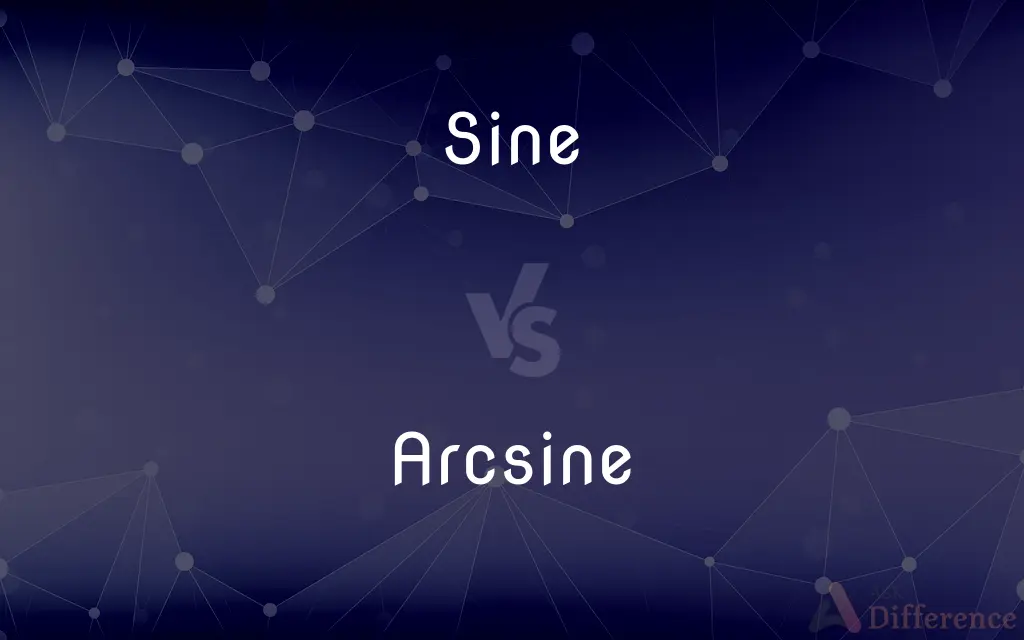Sine vs. Arcsine — What's the Difference?
By Tayyaba Rehman — Updated on September 27, 2023
Sine is a trigonometric function of an angle, while Arcsine gives the angle for a given sine value.

Difference Between Sine and Arcsine
Table of Contents
ADVERTISEMENT
Key Differences
Hydrogenation is a chemical process that involves the addition of hydrogen, usually to unsaturated fats or oils, making them more saturated. In contrast, reduction is a more generalized term representing any chemical reaction that involves the gain of electrons or a decrease in oxidation state. While hydrogenation specifically necessitates the presence of hydrogen, reduction can occur through various means and doesn’t necessarily involve hydrogen.
Hydrogenation is typically employed in the food industry to convert liquid oils into solid fats, thereby altering the texture and shelf-life of food products. Reduction, on the other hand, is a fundamental concept in chemistry and can be seen in myriad reactions, involving not only organic compounds but also inorganic ones. These reactions are not limited to the food industry but span across various scientific fields and applications.
In hydrogenation, the reaction specifically involves the use of hydrogen gas, and typically a catalyst like nickel is used to facilitate the reaction. Reduction, being a broader term, can involve various reagents and can be achieved by different methods, like the removal of oxygen, addition of hydrogen, or addition of electrons, depending on the context of the chemical equation.
Hydrogenation primarily focuses on modifying the physical properties of substances, particularly in the context of food production. However, reduction reactions encompass a variety of chemical processes and applications, such as the reduction of metal ores to obtain pure metals. Both processes are critical in their respective fields, but they have different scopes and applications.
While hydrogenation is a subtype of reduction, not all reduction reactions are hydrogenation reactions. This distinction arises because reduction reactions can involve different elements and compounds, reflecting the diversity and versatility of reduction reactions in chemistry, compared to the more specialized and focused nature of hydrogenation processes.
ADVERTISEMENT
Comparison Chart
Definition
Addition of hydrogen to molecules.
General term for gain of electrons.
Reactants
Involves hydrogen gas.
Can involve various reagents.
Applications
Primarily in the food industry.
In various chemical processes and industries.
Scope
Specific type of reduction.
Broad, includes many types of reactions.
Outcomes
Alters physical properties of fats.
Can yield various products, depending on reactants.
Compare with Definitions
Sine
Hydrogenation is a chemical process where hydrogen is added to a substance.
The hydrogenation of olive oil creates a product with a different texture.
Arcsine
Reduction is a chemical reaction that involves the gain of electrons or a decrease in oxidation state.
In batteries, the chemical energy is released through a series of reduction reactions.
Sine
Hydrogenation is often used in the food industry to improve the shelf life of products.
The hydrogenation of oils in snack foods can extend their shelf life.
Arcsine
Reduction can involve the removal of oxygen or the addition of hydrogen to a molecule.
The reduction of iron ore involves removing oxygen to produce iron metal.
Sine
Hydrogenation requires a catalyst, usually a metal, to proceed.
Nickel is often used as a catalyst in hydrogenation reactions.
Arcsine
Reduction reactions are ubiquitous and occur in various chemical processes across different industries.
The reduction of metals from their ores is a fundamental process in metallurgy.
Sine
Hydrogenation can contribute to the alteration of the nutritional value of food items.
The hydrogenation of edible oils can increase the level of trans fats in food.
Arcsine
Reduction is essential for balancing chemical equations as it pairs with oxidation in redox reactions.
The reduction of copper ions is coupled with the oxidation of zinc in a galvanic cell.
Sine
Hydrogenation typically involves the conversion of unsaturated fats to saturated fats.
Through hydrogenation, liquid vegetable oils are transformed into solid or semi-solid fats.
Arcsine
Reduction can occur through various methods and doesn’t necessarily involve hydrogen.
The reduction of a carbonyl compound can be achieved using sodium borohydride.
Sine
In mathematics, the sine is a trigonometric function of an angle. The sine of an acute angle is defined in the context of a right triangle: for the specified angle, it is the ratio of the length of the side that is opposite that angle, to the length of the longest side of the triangle (the hypotenuse).
Arcsine
(trigonometry) Any of several single-valued or multivalued functions that are inverses of the sine function. Symbol: arcsin, sin−1 Category:en:Trigonometric functions Category:en:Functions
Sine
The ordinate of the endpoint of an arc of a unit circle centered at the origin of a Cartesian coordinate system, the arc being of length x and measured counterclockwise from the point (1, 0) if x is positive or clockwise if x is negative.
Sine
In a right triangle, the ratio of the length of the side opposite an acute angle to the length of the hypotenuse.
Sine
In a right triangle, the ratio of the length of the side opposite an angle to the length of the hypotenuse. Category:en:Trigonometric functions Category:en:Functions
Sine
The length of a perpendicular drawn from one extremity of an arc of a circle to the diameter drawn through the other extremity.
Sine
Without.
Sine
Ratio of the opposite side to the hypotenuse of a right-angled triangle
Common Curiosities
How is the arcsine function related to the sine function?
Arcsine is the inverse of the sine function, providing the angle for a given sine value.
What is the domain of the arcsine function?
The domain of arcsine is [-1, 1].
In which quadrant are the values of arcsine positive?
The values of arcsine are positive in both the 1st and 2nd quadrants.
Why might someone use the arcsine function in real-world applications?
Arcsine is used to determine angles when the ratio of sides in right triangles is known.
Are there any restrictions on the inputs to the arcsine function?
Yes, the input to the arcsine function must lie between -1 and 1.
Can we determine the height of an object using the sine function?
Yes, using the sine function and a known angle of elevation, one can determine the height of an object.
Can sine values exceed 1 or go below -1?
No, sine values range between -1 and 1.
How does the sine curve look graphically?
The sine curve looks like a wave oscillating between -1 and 1.
Can arcsine give values outside of -90° to 90°?
No, the range of arcsine is from -90° to 90°.
Is the sine function even or odd?
The sine function is an odd function.
Are sine and arcsine functions bijective?
While sine is not bijective on its entire domain, arcsine is bijective on its domain of [-1, 1].
What happens if we try to find the arcsine of a number greater than 1?
The arcsine of a number outside the interval [-1, 1] is undefined.
If I have the sine value and want to know the corresponding angle, which function should I use?
You should use the arcsine function to determine the angle for a given sine value.
Share Your Discovery

Previous Comparison
Chieftain vs. Chief
Next Comparison
Snob vs. PretentiousAuthor Spotlight
Written by
Tayyaba RehmanTayyaba Rehman is a distinguished writer, currently serving as a primary contributor to askdifference.com. As a researcher in semantics and etymology, Tayyaba's passion for the complexity of languages and their distinctions has found a perfect home on the platform. Tayyaba delves into the intricacies of language, distinguishing between commonly confused words and phrases, thereby providing clarity for readers worldwide.
















































